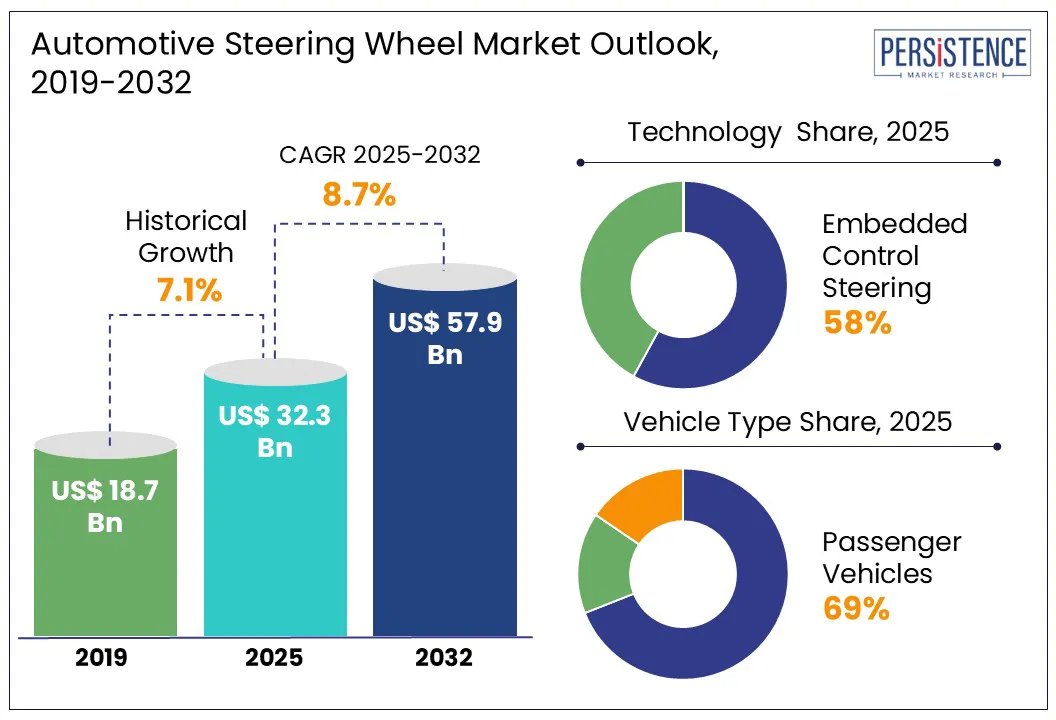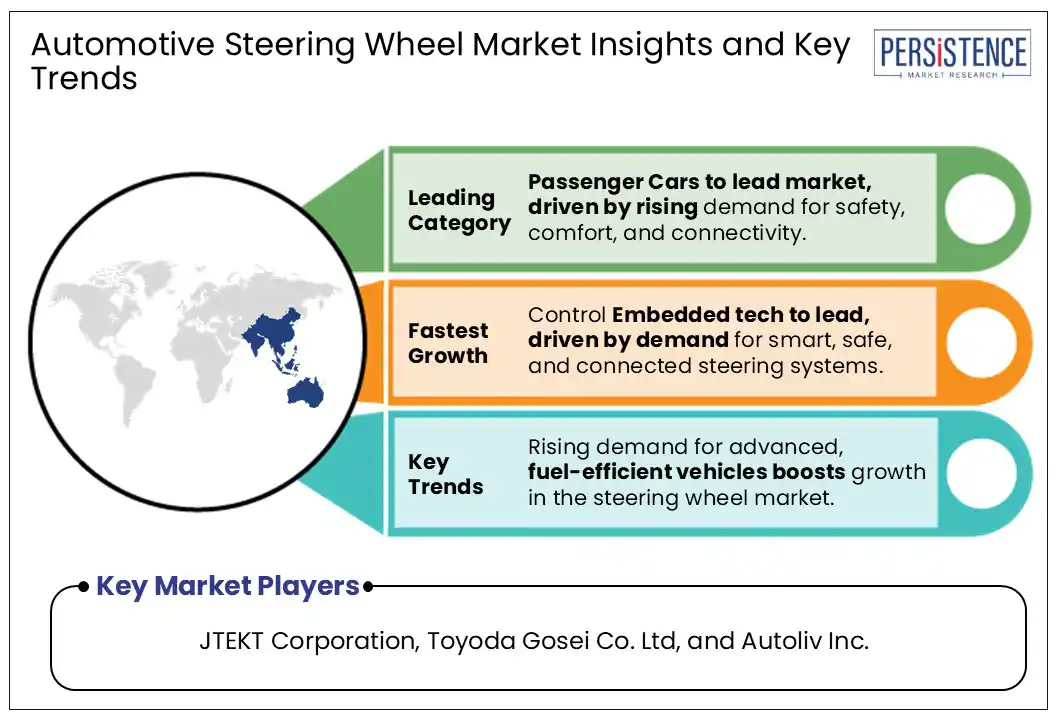ID: PMRREP16984| 198 Pages | 25 Jun 2025 | Format: PDF, Excel, PPT* | Automotive & Transportation

The global automotive steering wheel market size is likely to value at US$ 32.3 Bn in 2025 and is expected to grow at US$ 57.9 Bn by 2032, at a whopping CAGR of 8.7% by 2032.
The automotive steering wheel is more than a functional component for steering, it serves as a critical interface between the driver and the vehicle. Key market trends include rising demand for high performance vehicles, need for enhanced auto services, growing demand for lightweight vehicles, rise in automobile production and favorable economic conditions.
The rise of electric vehicles and the push toward lightweight materials are significant drivers for the market growth. EVs benefit from lightweight steering wheels to maximize efficiency and extend driving range, aligning with the overall goal of reducing vehicle weight to enhance performance and sustainability.

Key Industry Highlights:
|
Global Market Attribute |
Key Insights |
|
Automotive Steering Wheel Market Size (2025E) |
US$ 32.3 Bn |
|
Market Value Forecast (2032F) |
US$ 57.9 Bn |
|
Projected Growth (CAGR 2025 to 2032) |
8.7% |
|
Historical Market Growth (CAGR 2019 to 2024) |
7.1% |
To meet the ongoing demand for fuel efficiency and other technical advancements, the automotive sector is subject to numerous rules and regulations. Automakers and other component manufacturers have improved the existing systems in their vehicles. Many automakers have transitioned from mechanical and hydraulic steering to electric power steering systems to reduce emissions, reorganize complex mechanics, and offer a better comfortable driving experience.
Since electrically assisted steering systems offer several advantages over mechanical and hydraulic steering systems, including lower fuel consumption, reduced overall weight of steering systems, and lower maintenance, automotive regulatory authorities and governments are proposing various standards to encourage automakers to adopt them.
The automotive regulatory agencies are also working on future trends for hybrid power steering systems, which are divided into three categories: environment-friendly technologies for environmental regulations such as reducing emissions and improving fuel economy, technology for driver convenience using an automotive steering control system, and safety technologies to protect drivers, passengers, and other pedestrians.
The rapid advancement toward autonomous driving technologies and drive-by-wire systems presents a significant restraint for traditional automotive steering wheel manufacturers. Such technologies eliminate the need for mechanical steering controls, potentially altering the role and design requirements of steering wheels in future vehicle models.
Autonomous vehicles equipped with drive-by-wire systems replace traditional mechanical steering mechanisms with electronic controls. This shift reduces the complexity and size of steering wheels which impacts demand for traditional steering wheel components.
Autonomous vehicles require steering wheels with multifunctional interfaces, retractable design, or alternative control mechanisms to accommodate varying levels of autonomy and passenger preferences. Adapting to these design requirements poses challenges for traditional steering wheel manufacturers. The emergence of new entrants specializing in electronic control systems and autonomous vehicle technologies intensifies market competition. Established steering wheel manufacturers must innovate rapidly to remain competitive in a shifting automotive industry.
Steer-by-wire technology is gaining traction amid increasing environmental concerns and stringent regulations focused on driver safety and comfort. This innovative system eliminates the traditional mechanical link between the steering wheel and the wheels, replacing it with electronic controls, sensors, and software. By removing bulky mechanical components, steer-by-wire significantly reduces vehicle weight, contributing to improved fuel efficiency and lower carbon emissions a key focus for automakers striving to meet global emission standards.
Beyond environmental benefits, this technology enhances vehicle stability and handling, requiring less steering effort and enabling greater precision. It also supports the advancement of autonomous driving by offering flexible steering control. Major automotive players such as Bosch, Nissan, and Nexteer have made significant strides in developing and promoting steer-by-wire systems, signaling growing industry adoption. According to industry insights, steer-by-wire is expected to become a core component of next-generation vehicles, driven by the shift toward electrification, autonomy, and digitalization in the automotive sector.
Embedded control steering wheels incorporate advanced technologies such as electronic control units (ECUs), sensors, and actuators directly within the steering wheel assembly. These technologies enable precise control and communication between the driver and the vehicle's electronic systems, enhancing overall vehicle performance, safety, and comfort. The dominance of the embedded control steering segment in the global automotive steering wheel market is underpinned by its continual evolution through technological advancements.
Some of the leading steering manufacturers such as Autoliv Inc, ZF Friedrichshafen AG, and Nexteer Automotive Corp are at the forefront of this innovation. They are actively developing next-generation steering technologies such as steer-by-wire, direct adaptive steering, and intuitive steering systems.
The transition to electric vehicles (EVs) is predicted to drive growth in the passenger car segment of the automotive steering system market. Passenger automobiles currently dominate the automotive steering system market. Electric vehicles need efficient and precise steering systems to supplement their superior propulsion technologies. Electric power steering (EPS) systems are gaining popularity in EVs due to their energy economy and adaptability to vehicle automation and electrification features.
Passenger automobiles account for the vast majority of worldwide vehicle production. The transition to electric vehicles (EVs) is occurring predominantly in the passenger car segment. EVs benefit tremendously from Electric Power Steering (EPS) systems due to their fuel efficiency and compatibility with electric motors; the expansion of EVs strongly correlates with an increase in EPS usage for passenger vehicles. Developments in driver assistance features are mainly focused on passenger car safety and comfort, which drives up demand for improved steering systems in this market.

The rapid adoption of Electric Power Steering (EPS) technology, particularly in passenger cars and light commercial vehicles, is significantly boosting the automotive steering sensor market in China. As a global electronics manufacturing hub, China benefits from faster EPS integration, driven by demand for improved fuel efficiency and driving comfort. In India, stricter emission norms like BS-VI and increasing safety regulations have encouraged OEMs to transition from Hydraulic Power Steering (HPS) to EPS. The rising demand for electric vehicles further supports EPS adoption.
In the agricultural sector, the HPS segment is expected to see increased demand as it replaces traditional manual steering in tractors. Japan, known for its advanced automotive industry is experiencing high levels of vehicle electrification, with EPS gaining traction in passenger cars and Electro-Hydraulic Power Steering (EHPS) expanding in commercial vehicles. Although Asia Pacific may face a slower growth rate due to global economic challenges, it is expected to be less impacted than Western regions.
North America is leading innovation in the automotive steering wheel market, driven by advancements in electric power steering, steer-by-wire systems, and integration of advanced sensors for enhanced safety and driver assistance. Key manufacturers such as Nexteer Automotive Corp and Autoliv Inc. are pioneering modular, lightweight steering systems that improve precision and adaptability across vehicle types, including electric and autonomous vehicles. The region benefits from strong R&D investments focused on human-machine interfaces (HMI) and steering-mounted electronics, including gesture recognition technology.
The market is supported by rising adoption of advanced driver-assistance systems (ADAS) and regulatory emphasis on emissions reduction and vehicle safety. For example, Nexteer launched a Modular Rack-Assist Electric Power Steering System in 2023, showcasing North America’s leadership in flexible, scalable steering solutions. The steering wheel armature market here is projected to grow robustly, reflecting these technological and regulatory drivers.
Europe is a prominent player in the global automotive steering wheel market, driven by strong automotive manufacturing base, stringent safety regulations, and growing demand for advanced vehicle technologies. European automakers are at the forefront of integrating intelligent features into steering wheels, such as adaptive controls, biometric authentication, and haptic feedback systems.
The region's focus on sustainable mobility and vehicle electrification has accelerated the adoption of steer-by-wire and other lightweight, electronic steering technologies that contribute to fuel efficiency and reduced emissions.
Germany, home to major OEMs such as BMW, Mercedes-Benz, and Volkswagen, leads in R&D investment for premium, multifunctional steering wheels. Meanwhile, Tier 1 suppliers such as ZF Friedrichshafen and Continental are actively developing steering solutions compatible with autonomous and connected vehicles.
Competition is fueled by ongoing advancements in steering wheel technologies. Companies are investing in research and development to enhance safety features, integrate advanced materials, and support functionalities for electric and autonomous vehicle.
The automotive steering system market is a dynamic and competitive space, characterized by a diverse range of players vying for market share. These players are on the run for solidifying their presence through the adoption of strategic plans such as collaborations, mergers, acquisitions, and political support.
To strengthen market positions and expand technological capabilities, companies are forming strategic alliances with automotive manufacturers, technology firms, and research institutions. These collaborations aim to drive innovation and respond effectively to evolving demands in the market.
The Automotive Steering Wheel market is estimated to be valued at US$ 32.3 Bn in 2025.
Rising demand for connected and autonomous vehicle and Increasing focus on driver safety and ergonomic design are the key demand driver for Automotive Steering Wheel market
The industry is estimated to rise at a CAGR of 8.7% through 2032.
Integration of Advanced Technologies, and Growth of Electric and Autonomous Vehicles are the key market opportunities.
The global ambient lighting market is dominated by major players such as JTEKT Corporation, Toyoda Gosei Co. Ltd, and Autoliv Inc.
|
Report Attributes |
Details |
|
Historical Data/Actuals |
2019 - 2024 |
|
Forecast Period |
2025 - 2032 |
|
Market Analysis Units |
Value: US$ Bn, Volume: As applicable |
|
Geographical Coverage |
|
|
Segmental Coverage |
|
|
Competitive Analysis |
|
|
Report Highlights |
|
|
Customization and Pricing |
Available upon request |
By Sales Channel
By Product Type
By Vehicle Type
By Technology
By Region
Delivery Timelines
For more information on this report and its delivery timelines please get in touch with our sales team.
About Author